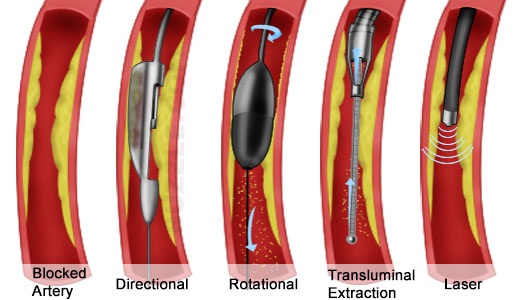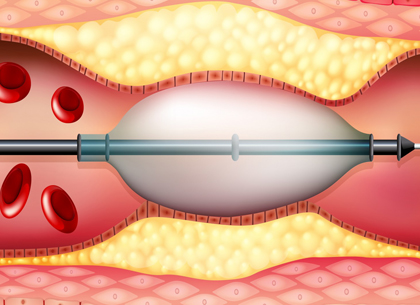An atherectomy is a procedure that utilizes a catheter with a sharp blade on the end to remove plaque from a blood vessel. The catheter is inserted into the artery through a small puncture in the artery, and it is performed under local anesthesia. The catheter is designed to collect the removed plaque in a chamber in the tip, which allows removal of the plaque as the device is removed from the artery. The process can be repeated at the time the treatment is performed to remove a significant amount of disease from the artery, thus eliminating a blockage from atherosclerotic disease.

The goal of treatment is to eliminate the build-up of plaque in your arteries.
You may need this atherectomy procedure if your arteries become too narrowed or blocked from plaque inside the artery walls. If arteries are blocked, blood cannot get through to nourish the tissues, causing the muscles of the lower extremities to cramp and lose strength.
An atherectomy is especially helpful for treating blockages in arteries that occur around branches or in vessels that are not easily treated with stents.
This procedure is not ideal for everyone. Each patient is evaluated, and treatment will be individualized for the patient’s circumstances.

Your doctor will discuss the specific risks and potential benefits of the recommended procedure with you.
Atherectomy usually has no complications, but as with any surgery, there is a risk of complications, such as embolization (the dislodgement of debris that blocks the arteries in the lower part of the leg) and perforation. These complications, however, are rare. An unusual complication of atherectomy is the re-blockage of the artery (restenosis) that may occur later, especially if you smoke cigarettes.
Special precautions are taken to decrease these risks, and there may be other possible risks. When you meet with your doctor, please ask questions to make sure you understand the risks of the procedure and why the procedure is recommended.
A few days before the procedure, pre-procedure tests may be performed to ensure that it is safe to continue with the procedure. You may need to discontinue certain medications before the procedure. Your health care team will provide specific instructions to help you prepare.
The atherosclerosis atherectomy will be performed under local anesthesia with a mild sedative given intravenously. Your surgeon will insert a catheter equipped with a sharp blade at its tip and advance it through your artery until it reaches the area of narrowing. Your surgeon will then scrape away the plaque with the catheter blade. The plaque will be collected in a chamber in the tip of the catheter for removal. The surgeon may need to pass the catheter multiple times in order to remove a significant amount of atherosclerosis.
The procedure itself generally takes two hours, but the preparation and recovery time add several hours. Following the procedure, you will need to lie flat for three to six hours. The surgery may require a minimum hospital stay of one to two days.
You can usually begin normal activities again several days after the atherectomy. Your doctor will provide specific guidelines for your recovery.
